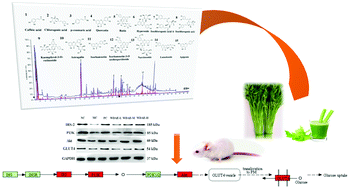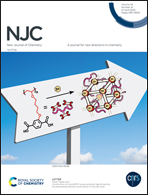Hypoglycemic effects of phenolic compound-rich aqueous extract from water dropwort (Oenanthe javanica DC.) on streptozotocin-induced diabetic mice
Abstract
Water dropwort aqueous extract (WDAE) was confirmed to be rich in phenolic compounds, and 5 phenolic acids and 10 flavonoids were identified by HPLC-ESI-QTOF-MS analysis in this study. The hypoglycemic effects of WDAE on streptozotocin-induced diabetic mice were then investigated. In comparison with the diabetic model group, the food intake, body weight loss, blood glucose and insulin level of the high-dose WDAE (400 mg kg−1 d−1) treatment group significantly (p < 0.05) reduced, and the glycogen contents in liver and muscle tissues of the WDAE (200 and 400 mg kg−1 d−1) groups remarkably (p < 0.05) increased. Moreover, WDAE treatment notably (p < 0.05) improved the glucose and insulin intolerance and insulin resistance and sensitivity of diabetic mice. Additionally, WDAE treatment suppressed oxidative stress by increasing the antioxidant activities of superoxide dismutase (SOD), catalase (CAT) and glutathione peroxides (GSH-Px) and the total antioxidant capacity (T-AOC), as well as decreasing the malonaldehyde (MDA) level. Furthermore, WDAE treatment could ameliorate insulin resistance via improving the signaling pathway of IRS-2/PI3K-AKT and activating GLUT4 translocation. Hence, all results indicated that WDAE might be a promising candidate for diabetes management.



 Please wait while we load your content...
Please wait while we load your content...